Centro Arte Reina Sofia
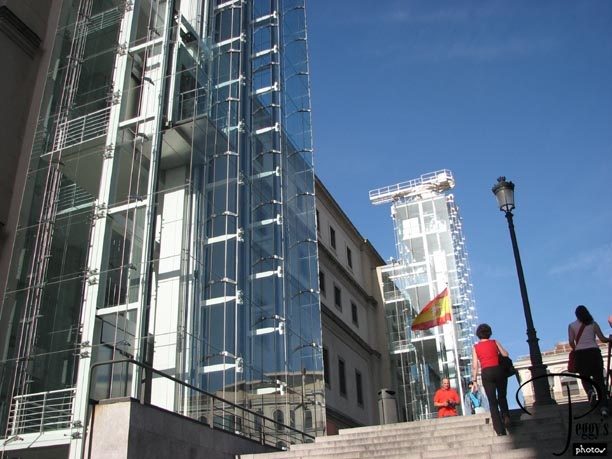
I didn’t get much sleep last night between coming back from the flamenco show and getting an early start again this morning. Today was our last day in Madrid until the end of our trip and we still had places to visit. We got on the metro near our hotel––well, I put us on a train in the wrong direction, which was okay as we could still transfer from it to the line that we needed to connect with. There was only one seat available in our subway car and Merrie told me that I should take it––a kindness which, however, had some unfortunate consequences for me when we were returning later on the metro. Our first stop today was the Centro Arte Reina Sofia, Madrid’s modern art museum (the museums are free on Sundays and they were crowded). We only went here to see their most famous painting––Guernica by Picasso. Photo is of the glass elevators outside the museum.

Centro Arte Reina Sofia
Centro Arte Reina Sofia
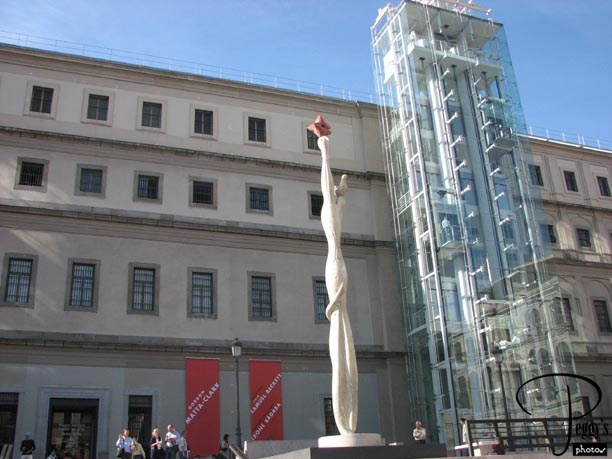
The front of the museum.

Centro Arte Reina Sofia
Guernica
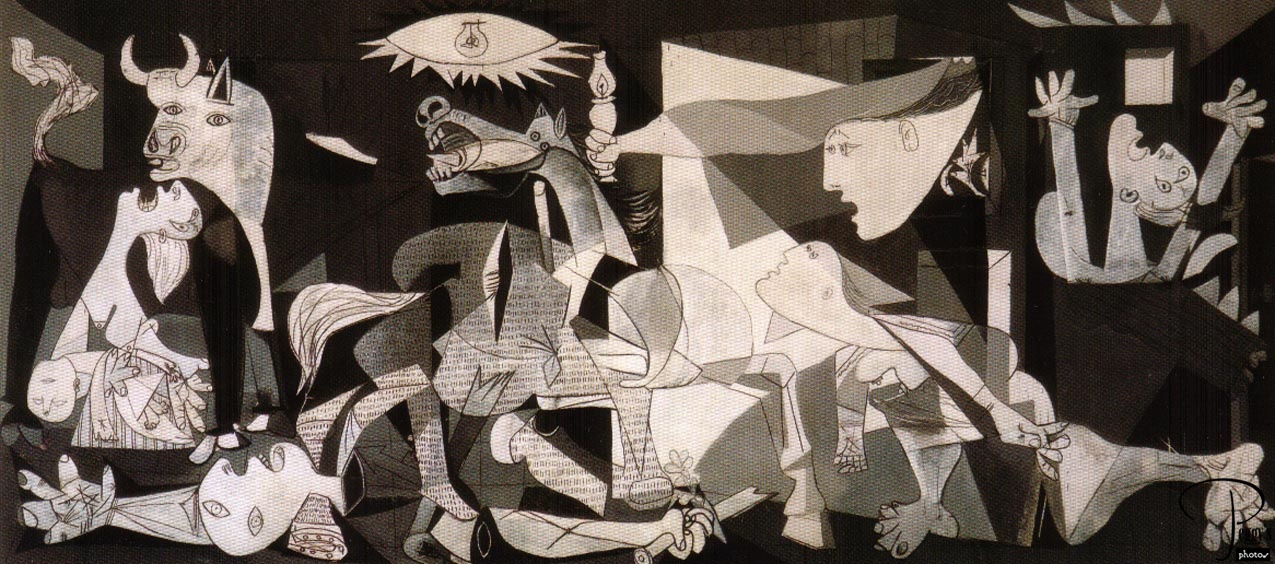
No photos were allowed be taken in the museum. This is a scan of a postcard of the famous painting by Picasso. Guernica is a village in northern Spain and in 1937 experienced the world’s first saturation bombing––approved by Franco and carried out by Hitler. Picasso painted “Guernica” as a warning of the growing peril of fascism.

Guernica
Outside the Centro Arte Reina Sofia
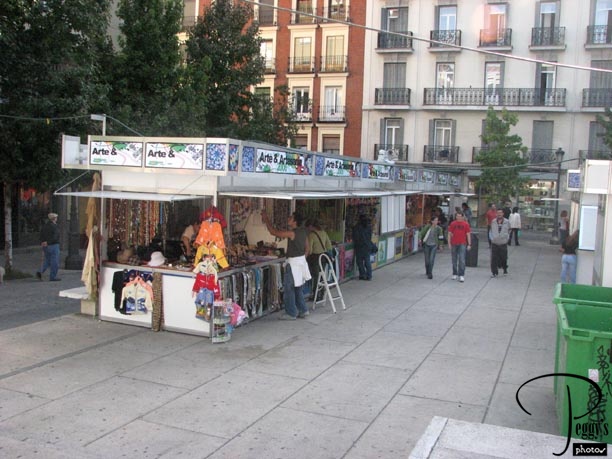
Art and souvenir booths outside the Reina Sofia. We didn’t have time for any shopping here as we had already spent time in the Reina Sofia’s gift store, where I bought a very large Picasso poster of a collage of his bullfight paintings. The store didn’t have any cardboard holders for the poster and I was wondering now how I was going to get it home in one piece.

Outside the Centro Arte Reina Sofia
Walk to the Prado
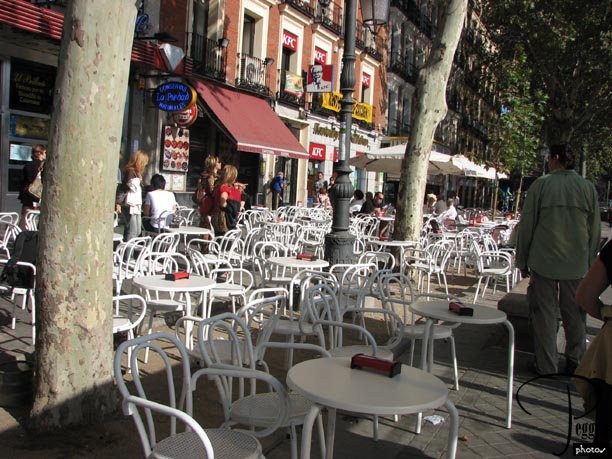
We walked from the Reina Sofia to the Prado Museum, about a 10–minute walk. We passed this cafe on the way––note the KFC outlet here.

Walk to the Prado
Walk to the Prado
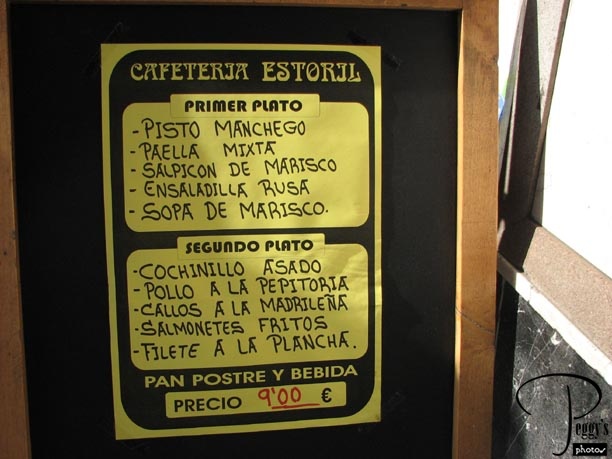
Cafeteria menu passed on the way. In Spain, cafeterias are usually not very interesting places to eat as they do not offer many menu choices. Inside them, there is usually only a small bar and a few tables.

Walk to the Prado
Walk to the Prado
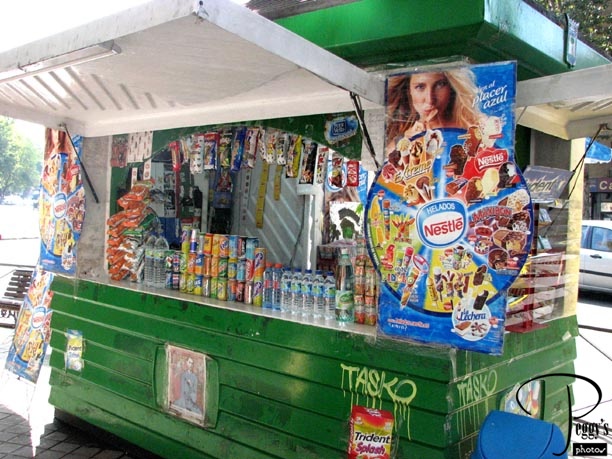
Junk food and water stand.

Walk to the Prado
Walk to the Prado
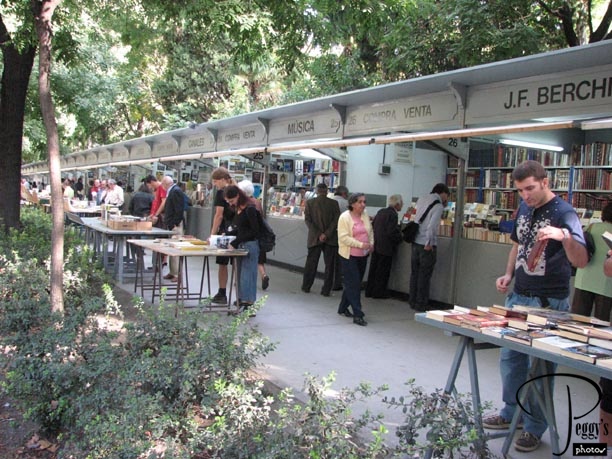
Book sellers and buyers stalls.

Walk to the Prado
Walk to the Prado
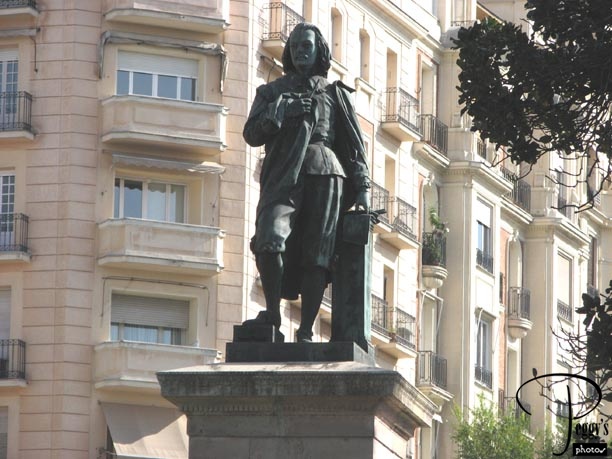
A statue passed along the way.

Walk to the Prado
Walk to the Prado
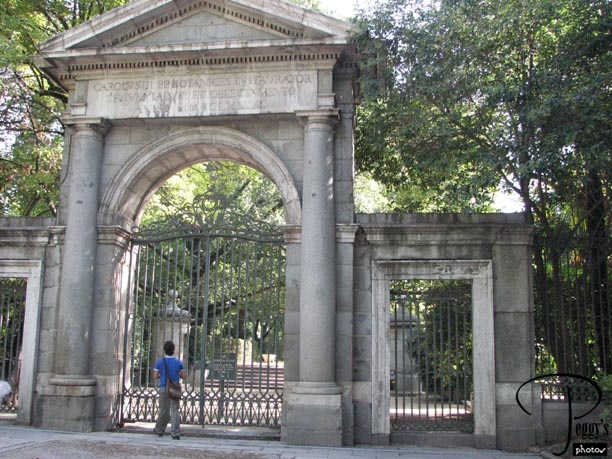
The Real Jardin Botanico (Charles III’s Botanical Garden).

Walk to the Prado
At the Prado
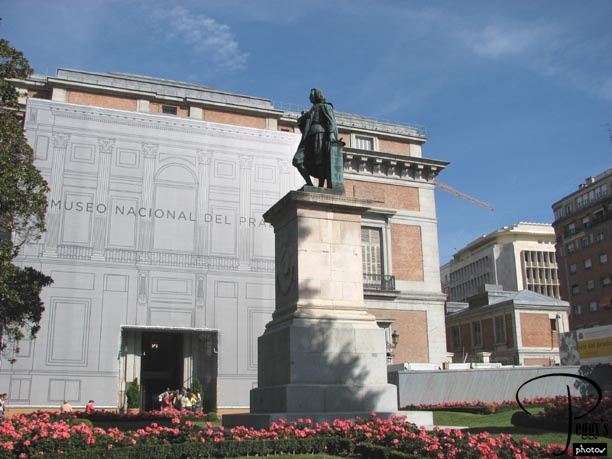
The front of the Prado, the Museo National del Prado. This is one of the world’s greatest museums with over 3000 paintings, including entire rooms of those of Velaquez, Goya, El Greco, and Bosch plus works by Peter Paul Ruebens, Raphael, Titan, etc., etc. It is hard to know if you have viewed all the paintings because of its layout of many small rooms off big rooms. Also, the placements of certain paintings also are changed often so that the map given at the door is then in error. I was trying to find the Bosch room and asked directions as to where its room number on the map was, but there were no Bosch paintings in that room. I should have asked “Where have you put the Bosch paintings?” instead. We spent much time here and ate lunch in their cafeteria (which had an adquate food selection). This photo is of the entrance to the Prado. The statue is of Velaquez. No photos were allowed in the museum.

At the Prado
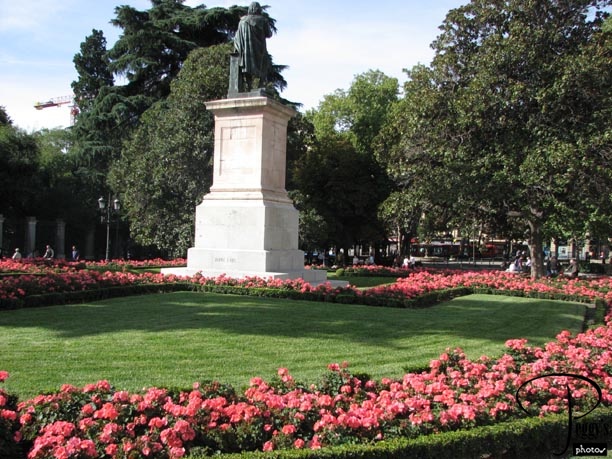
Statue of Velaquez. We had to leave the Prado as we had to be at the Julia Bus Company office on the Gran Via by 2:45 p.m. to go to the bullfights. We also had to stop at our hotel so I could drop off my Picasso poster. On the metro going back, there again was only one seat left. As I had the one available seat going to the museums, it was Merrie’s turn to sit down. I was standing near the train door when a couple got on who were trying to look like tourists––the man had a camera around his neck and the woman was carrying a bag from a tourist gift shop. Their coloring and facial features were such that I was having difficulty trying to figure out what country they were from. Their clothing also didn’t have that rumpled tourist look that it gets when taken out of a suitcase. But when they started crowding me and when I saw the woman’s hand moving under the jacket she had over her arm, I knew they were pickpockets. I also then realized that there were two more in their group––one man to keep me from moving backward too much and one man to keep me from moving forward too much. But I was able to move to the side, so they then moved to the side. I moved more to the side and then they also did. This went on until they got off at the next stop. They wouldn’t have gotten anything of value if they had been successful––they would have had a choice of my Rick Steves’ Spain book, my reading glasses, a water bottle, some tissues, or my Prado map. I had my money and credit card in a money belt. But the idea of being almost pickpocketed made me angry and still gives me the creeps. Merrie said that I should have yelled “No molesto” to get rid of them. I talked to someone from L.A. who was in Madrid the same time we were and he was pickpocketed on the Madrid subway, I think also on his way to the Prado. This almost–pickpocketing did make Merrie and me very aware of the people who were walking or standing near us, probably to the extent of becoming somewhat paranoid about it all.

Madrid Bus Tour
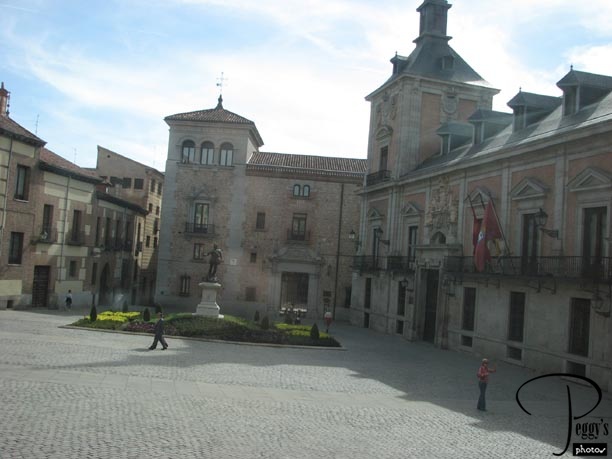
Before being dropped off at the bullfights, we were given a bus tour of Madrid. I took the following photos while on the bus. Building seen from the bus.

Madrid Bus Tour
Madrid Bus Tour
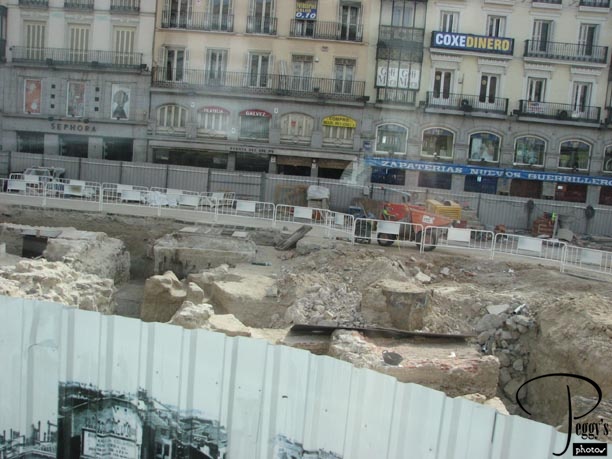
Subway excavation––they were finding Roman ruins during the excavation.

Madrid Bus Tour
Madrid Bus Tour

Always look up to the top of the buildings in Madrid.

Madrid Bus Tour
Madrid Bus Tour
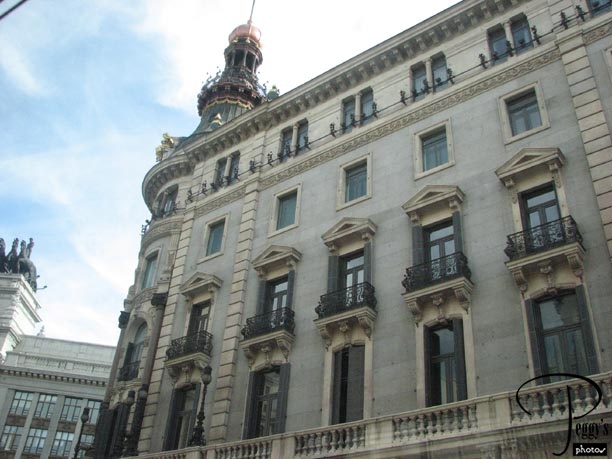
A beautiful Madrid building.

Madrid Bus Tour
Madrid Bus Tour
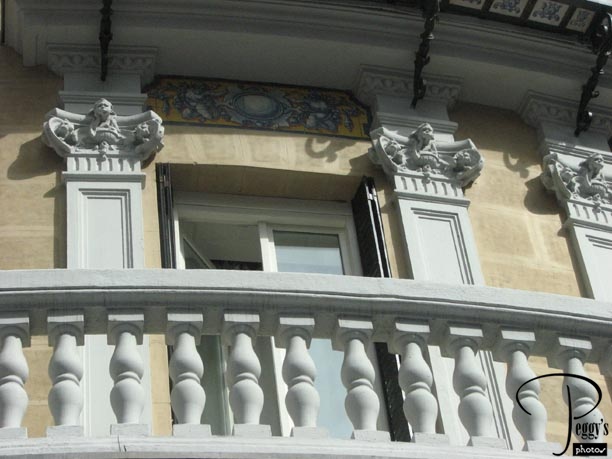
Close–up of reliefs and murals on the side of a building.

Madrid Bus Tour
Madrid Bus Tour
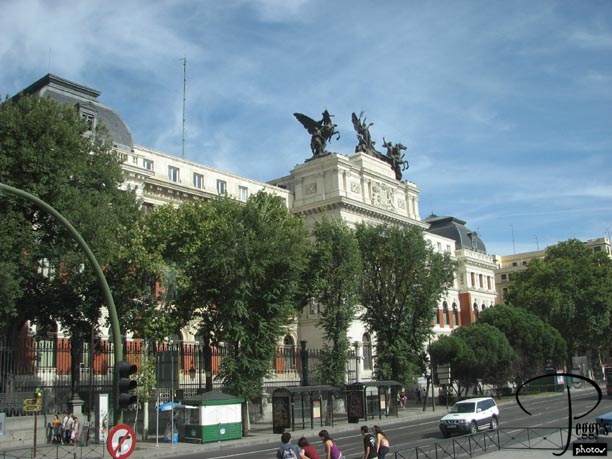
More statues on the top of a Madrid building.

Madrid Bus Tour
Madrid Bus Tour
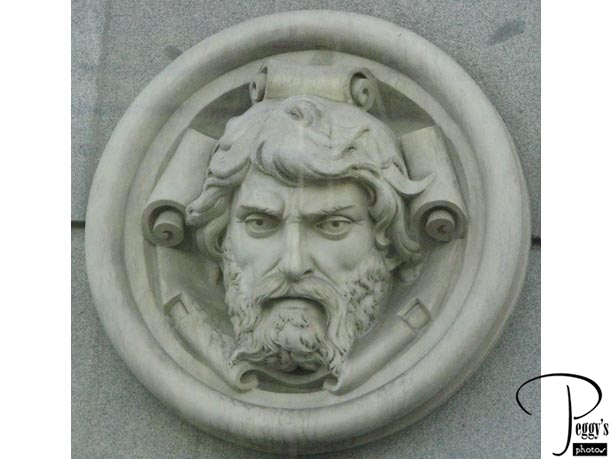
Relief on the side of a building.

Madrid Bus Tour
Madrid Bus Tour
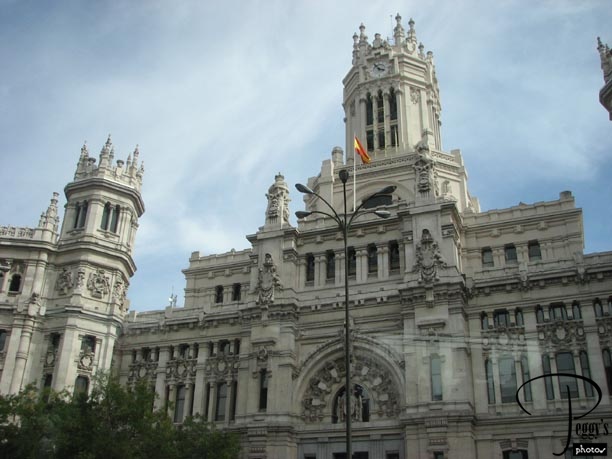
The Madrid post office.

Madrid Bus Tour
Madrid Bus Tour
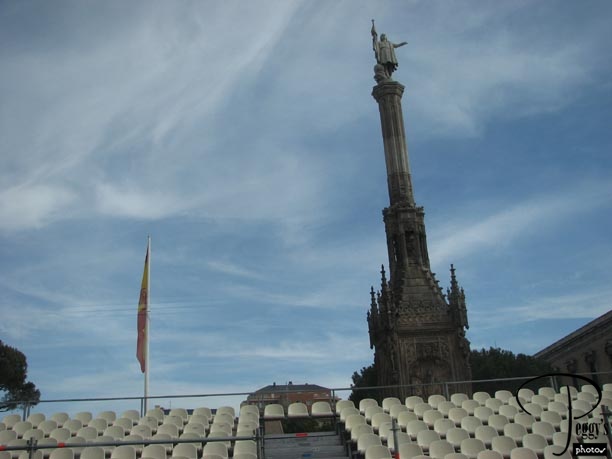
We stopped awhile at the Plaza de Colon as I think we made too good time on the bus tour and it wasn’t time yet to go to the bullfights. The chairs have been set up for the National Day Parade on October 12, this date, surprisingly, not celebrated as Columbus Day in Spain.

Madrid Bus Tour
Madrid Bus Tour
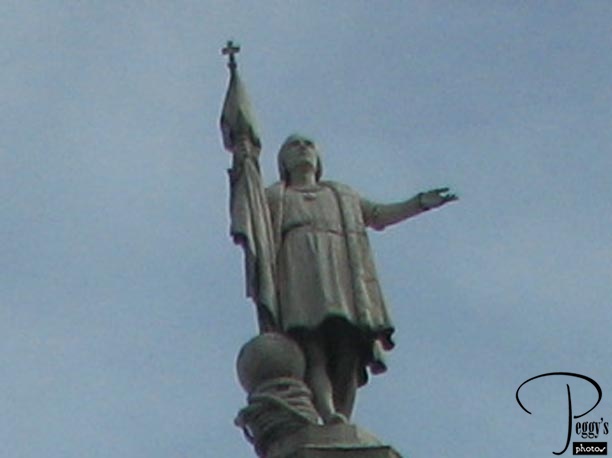
Close–up of statue of Christopher Columbus on top of the spire.

Madrid Bus Tour
Madrid Bus Tour
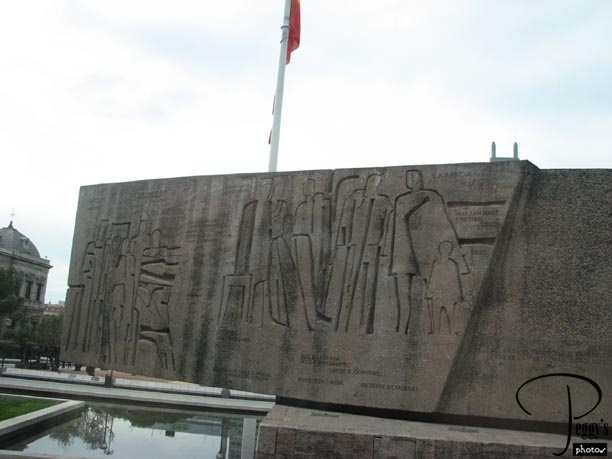
We had enough time at the Plaza de Colon for me to take this photo of one of the four concrete structures here that are inscribed with quotations and etched with drawings of Columbus’ journeys.

Madrid Bus Tour
Madrid Bus Tour
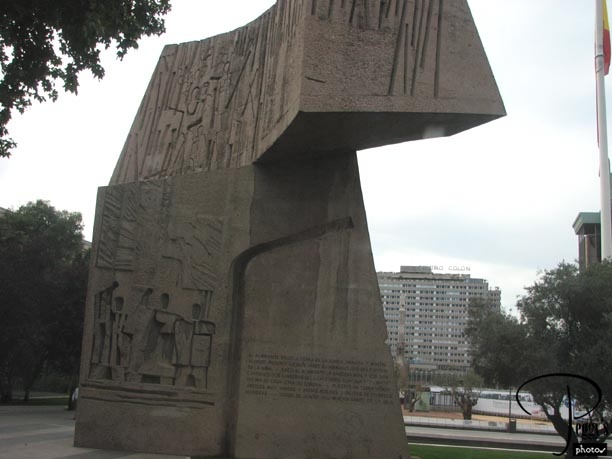
Another one of the concrete structures.

Madrid Bus Tour
Plaza de Toros
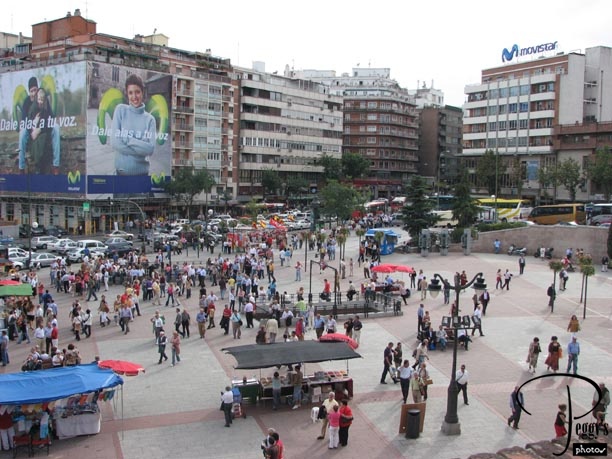
We were now looking down at the crowd from the second floor.

Plaza de Toros
Madrid Bus Tour
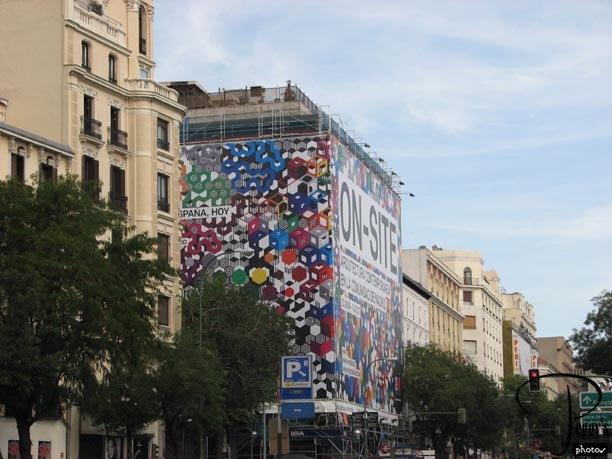
Colorful covering for a building under reconstruction seen from the Plaza de Colon.

Madrid Bus Tour
Madrid Bus Tour
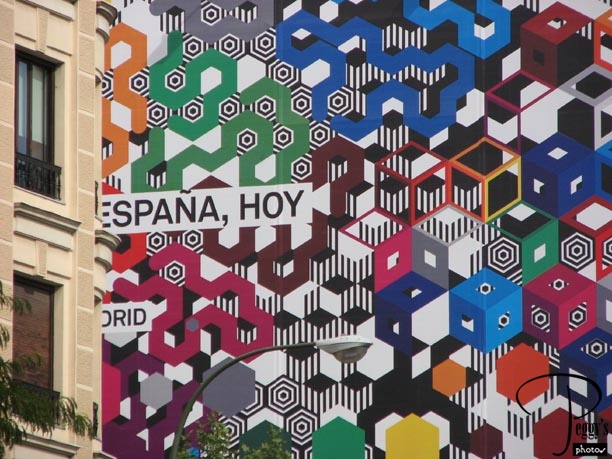
Close–up of the covering.

Madrid Bus Tour
Plaza de Toros
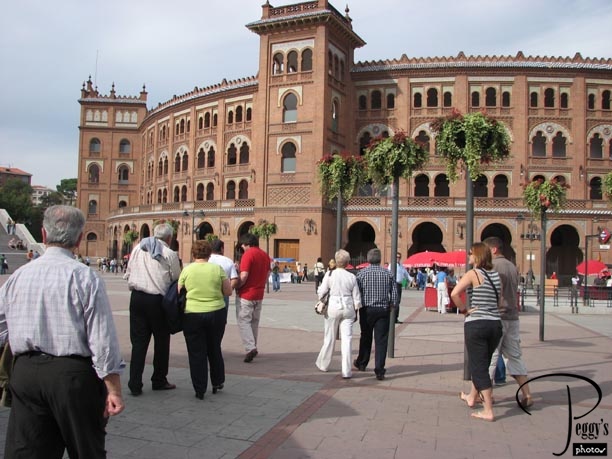
We have arrived at the Plaza de Toros de Las Ventes, Madrid’s bullring. Some of my family members and friends were not at all pleased that I was going to attend a bullfight. I told them that I had already been to the bullfights in Mexico City many many years ago. I remembered it as colorful and not gory. Memory can play tricks on you, as my impression now of a bullfight after this experience in Madrid is that, for spectators, it is to see how much gore you can stomach. I didn’t do too well. Merrie and I both agreed that we would never attend a bullfight again. I have put photos of the bullfight arena and some of the actual bullfights below. However, I have not put any photos on that are going to turn your stomach. You do not have to worry about flipping over to the next photo and finding something gory in it. This photo is of the Plaza de Toros.

Plaza de Toros
Plaza de Toros
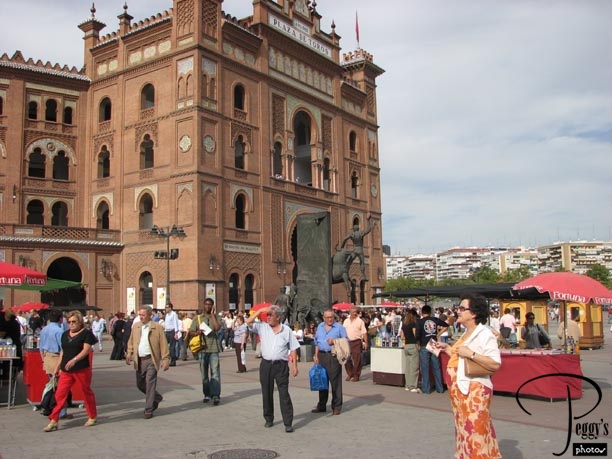
The Plaza de Toros de Las Ventes is so big that it take two photos to show it. It was built in 1929 in the Neo–Mudejar style, which is the Moorish style attributed to the Muslims that stayed in Spain after it was conquered by the Christians.

Plaza de Toros
Plaza de Toros
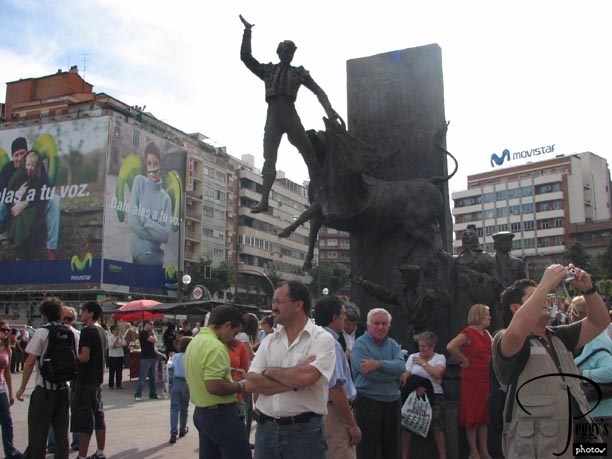
The bullfighter statue in front of the Plaza de Toros.

Plaza de Toros
Plaza de Toros
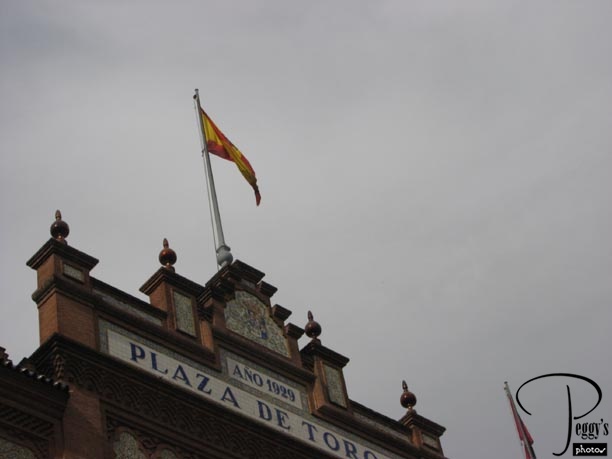
Top of its entrance.

Plaza de Toros
Plaza de Toros

The ticket booths.

Plaza de Toros
Plaza de Toros
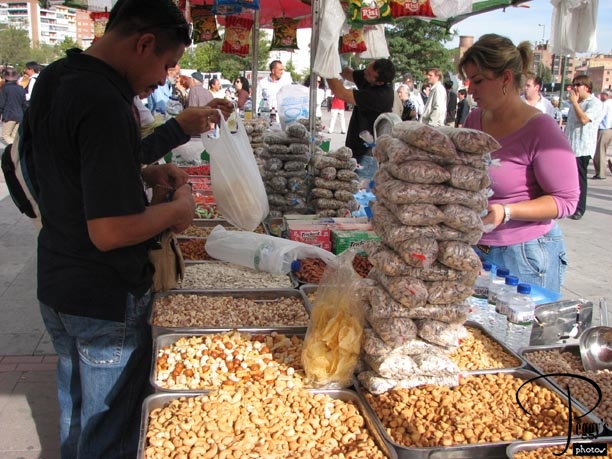
Snack stands. I bought some cashew nuts (expensive) and some cracker mix––second bin from the front on the left (inexpensive and very good). I also bought three T–shirts with bullfighting themes as gifts here but lost them, I believe, in the ladies room. As it turned out, I probably wouldn’t have given them to anyone anyway so I wouldn’t be reminded of the bullfights.

Plaza de Toros
Plaza de Toros
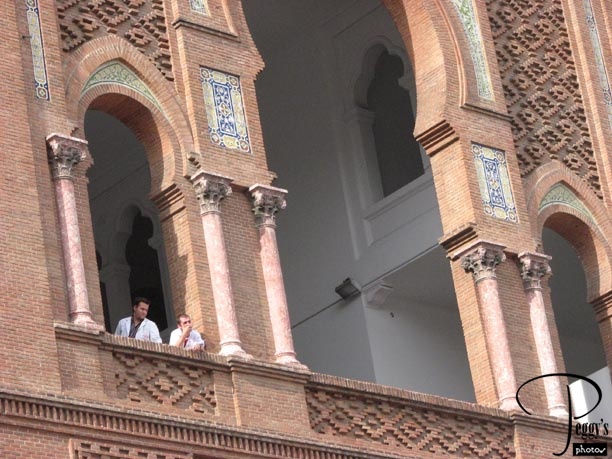
People on second floor looking down at the crowd.

Plaza de Toros
Plaza de Toros
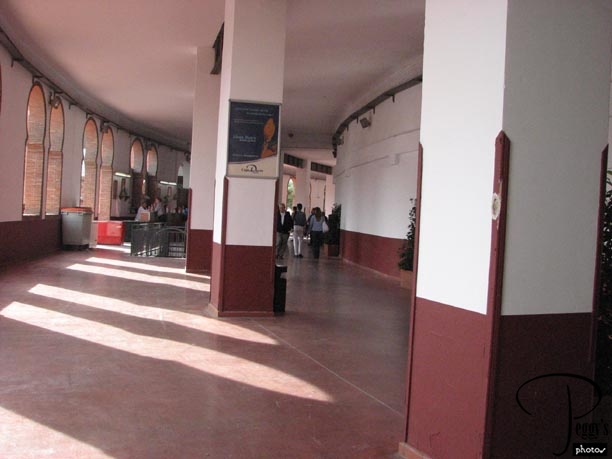
Second–floor corridor.

Plaza de Toros
Plaza de Toros
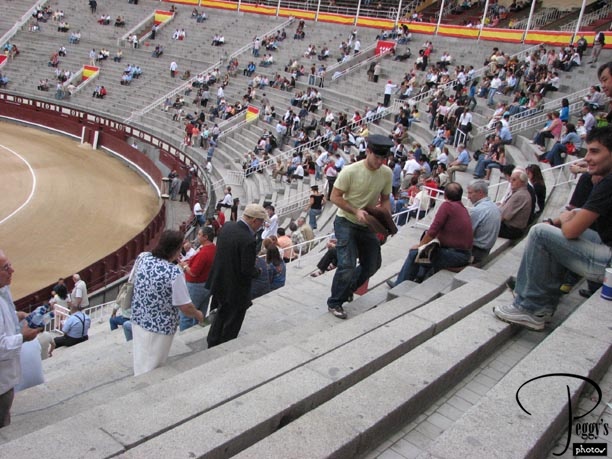
We rented seat cushions for 1 euro each. An usher took our tickets and led us to our seats. I insisted that he also hold my hand going up these steep steps.

Plaza de Toros
Plaza de Toros
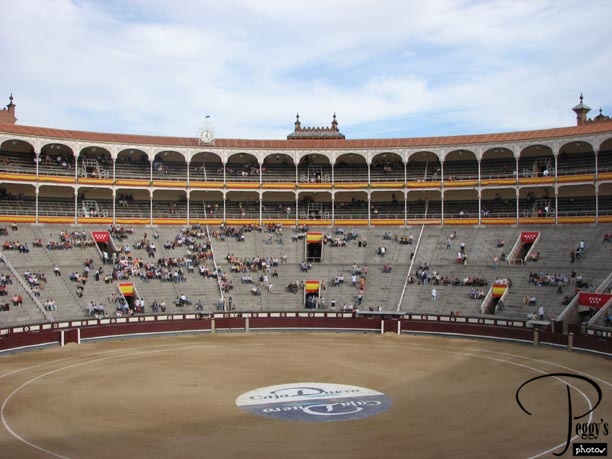
It is now 5:05 p.m. The bullfights are to start at 5:30 p.m. If you are not in your seat by 5:30 p.m., you are not allowed inside the arena for quite awhile. The people across from us are sitting on the sunny side. We paid extra to sit on the shady side.

Plaza de Toros
Plaza de Toros

Close–up of the tiers across from us.

Plaza de Toros
Plaza de Toros
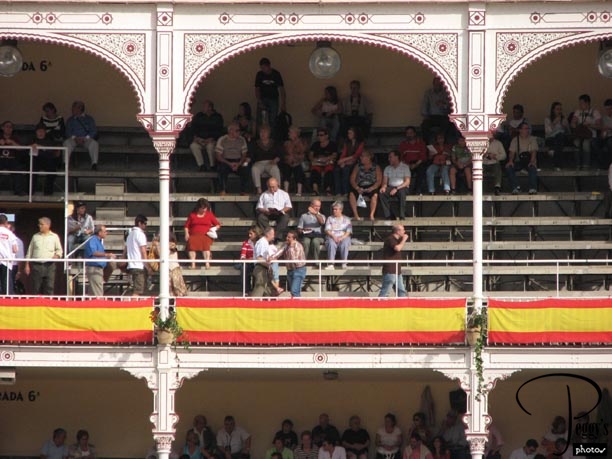
And a closer–up view.

Plaza de Toros
Plaza de Toros
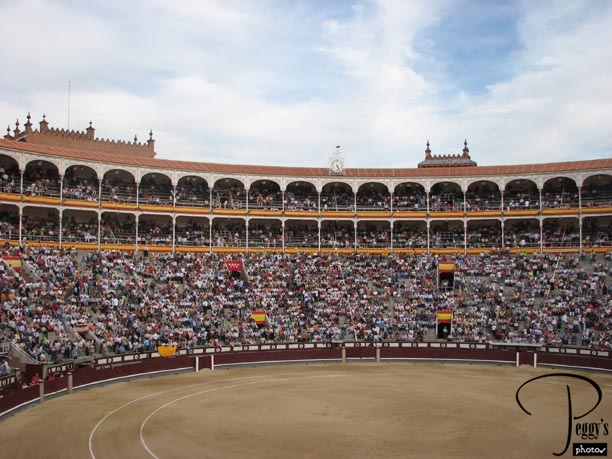
It is now 5:25 p.m.

Plaza de Toros
Plaza de Toros
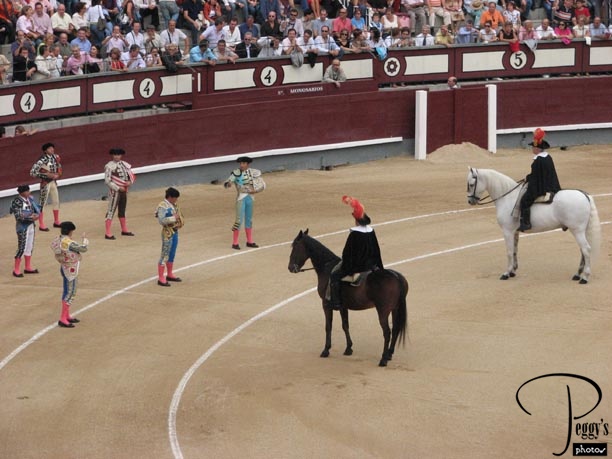
The start of the Paseillo (parade) opening the bullfights. The men on horseback are the alguacillos. They represent the presiding dignitary on the ground and follow his orders. The men standing, in the “suits of light,” are the matadors and banderillos. I have put a movie clip of part of the Paseillo on this website: Go to Movies, Western Europe, Spain, “Pasiello at Plaza de Toros, Madrid.”

Plaza de Toros
Plaza de Toros
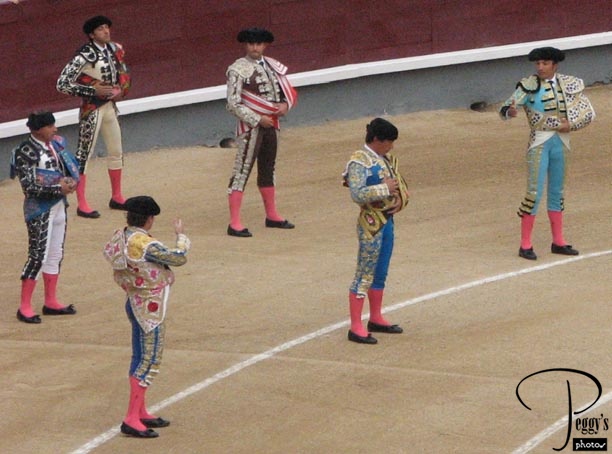
Close–up of the matadors and banderilleros.

Plaza de Toros
Plaza de Toros
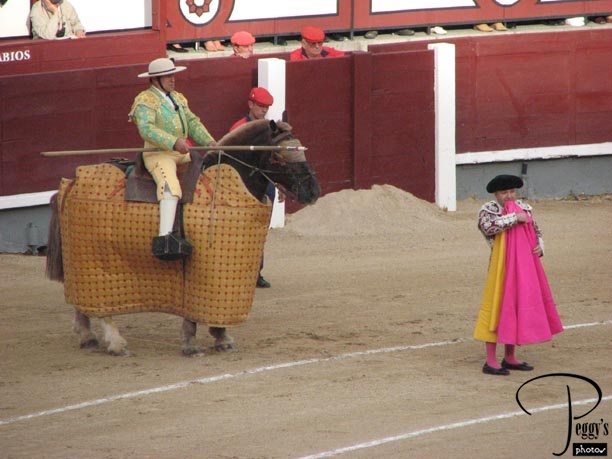
A picadore on horseback. Each bullfighter has his own team which includes two picadores and three banderilleros.

Plaza de Toros
Plaza de Toros

A banderillero. The banderilleros play with the bull in order to size him up for the matador. The banderilleros use pink and gold capes. After playing with the bull, the picadores inflict damage to the bull in order to weaken it and then the banderilleros plant two banderillas into the bull. Sometimes the matador plants the banderillas.

Plaza de Toros
Plaza de Toros
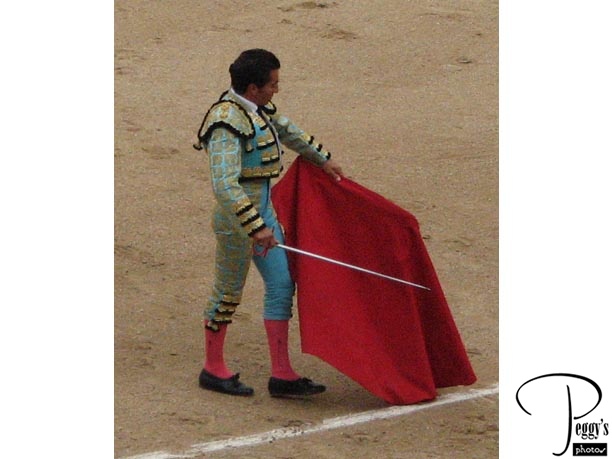
The matador. The matador uses a red cape. The bull can’t distinguish between a pink cape and a red cape, so the different colors are for the audience’s info. There are three matadors performing at the bullfights. The first matador appears in bullfight one and three; the second matador, in bullfights two and five; and the third, in three and six.

Plaza de Toros
Plaza de Toros
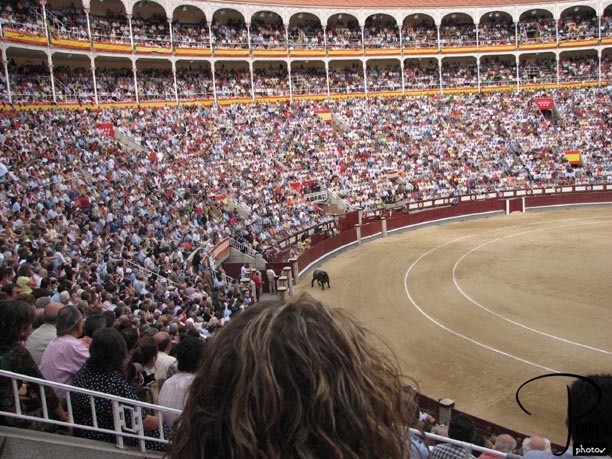
The most important participant, of course, is the bull. This photo shows the first bull making its entrance.

Plaza de Toros
Plaza de Toros
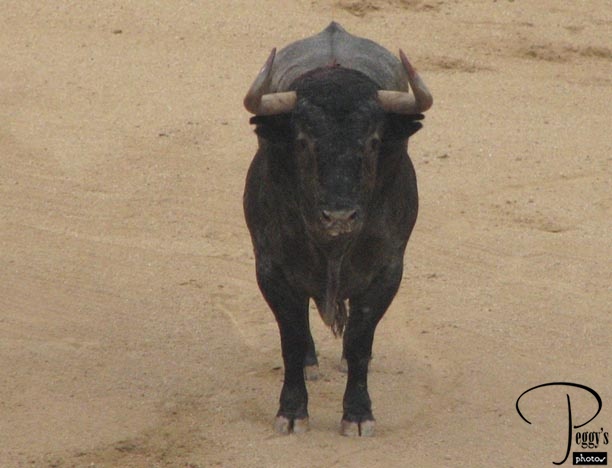
This bull, the first bull, was looking directly at a banderillero.

Plaza de Toros
Plaza de Toros
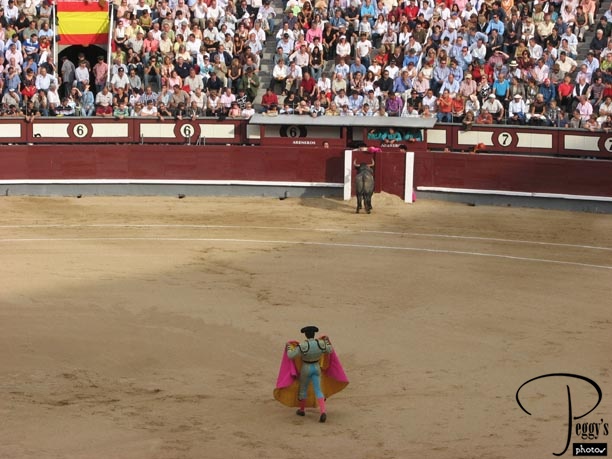
The banderillero in the foreground of the photo is trying to attract the bull’s attention. Right now, its attention is on the two banderilleros hiding behind the wall. The cape action that took place before I took this photo is on a movie clip on this website: Go to Movies, Western Europe, Spain, “Bull vs. Banderilleros, Plaza de Toros, Madrid.”

Plaza de Toros
Plaza de Toros
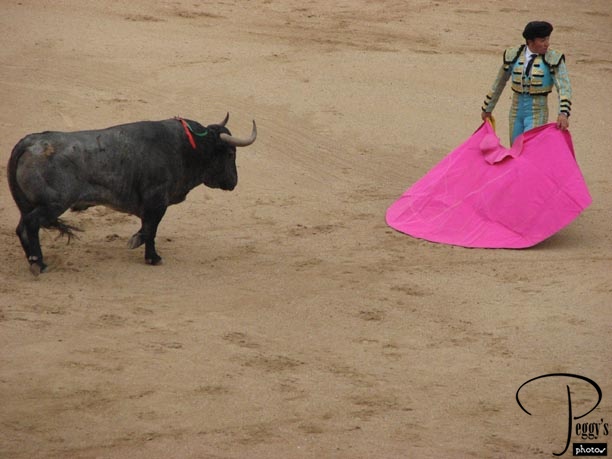
I don’t think it is a good idea for this banderillero to be looking away from the bull. The rosette on the bull’s back indicates by its colors the breeding estate that it is from.

Plaza de Toros
Plaza de Toros
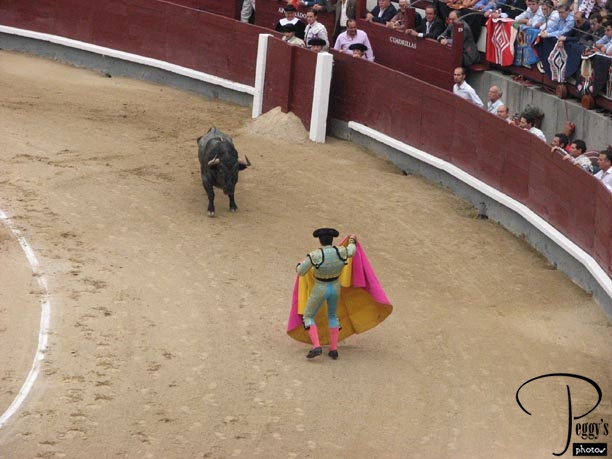
The bull’s attention has been attracted.

Plaza de Toros
Plaza de Toros
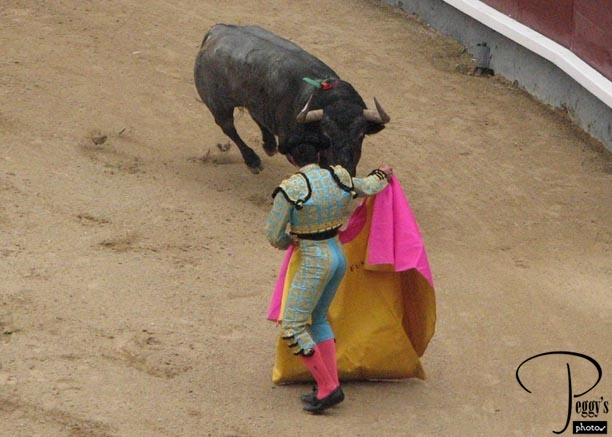
The bull begins its charge.

Plaza de Toros
Plaza de Toros
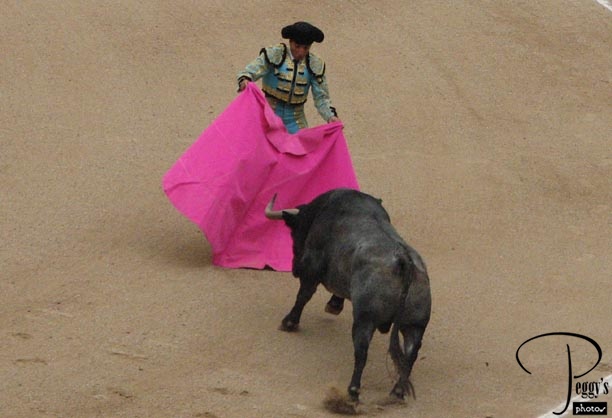
It’s a bit closer to the banderillero now.

Plaza de Toros
Plaza de Toros
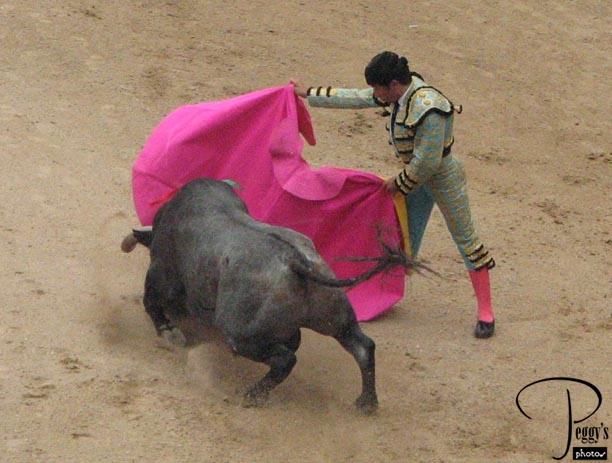
The bull charges.

Plaza de Toros
Plaza de Toros

The second bull.

Plaza de Toros
Plaza de Toros
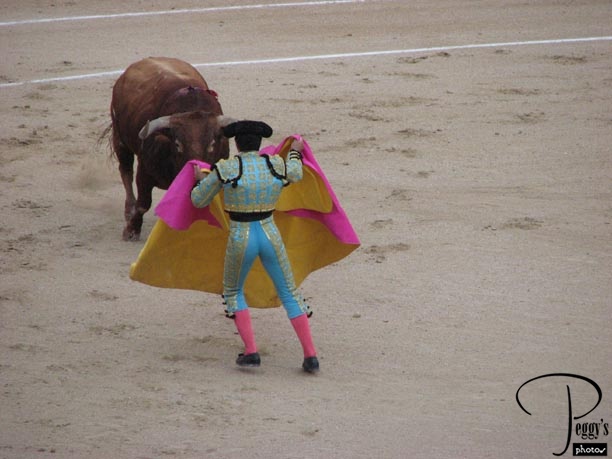
It is getting ready to charge.

Plaza de Toros
Plaza de Toros

I made it through two bullfights and then couldn’t take anymore of it. If I left the stands, I would have had to climb over many people and I really didn’t want to spend a couple of hours alone in the corridor. So, I decided to take a nap. I had so little sleep the night before that I was only awakened when the clapping and cheering got very loud. I remember hearing many “Ole’s” during the bullfights in Mexico City. I didn’t hear any “Ole’s” here in Madrid. Merrie stayed awake for all six bullfights, but I think she was spending much of her time improving her Spanish by talking to people sitting closeby in the stands. After the bullfights, we were to be taken back to our hotels. We knew now that this meant that we would be dropped off somewhere on the Gran Via. We got back to our hotel about 8:30 p.m., first stopping off at a convenience store where I was able to buy some tape to wrap around my Picasso poster’s plastic wrap to keep it from getting damaged in transist. We ate dinner at our hotel. I ordered salmon. I couldn’t believe that Merrie actually ordered meat––at least it wasn’t beef. We left Madrid the next day, but I felt like we only scratched Madrid’s surface as there were so many more places that I would have been interested in visiting there if we had had more time.
